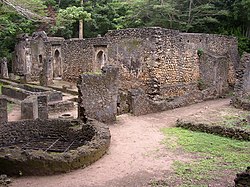Ruins of Gedi
The ruins of Gedi (also known as Gede) are a historical and archaeological site near the Indian Ocean coast in Kenya.[1]
| Ruins of Gedi | |
|---|---|
 Ruins of the Great Mosque at Gedi | |
| Location | Kilifi District, Kenya |
| Coordinates | 3°18′34″S 40°01′02″E / 3.3094°S 40.0172°E |
Overview
The site of Gedi includes a walled town and its outlying area. The earliest evidence for occupation at Gedi is a grave dating to between 1041 to 1278.[2][3] Gedi was abandoned in the middle of the seventeenth century.[1]
The Gedi ruins were first discovered by colonialists in 1884 after a British resident of Zanzibar, Sir John Kirk, visited the site.[1] However, Gedi remained unknown to most of British East Africa's colonists until the 1920s.
Gallery
- Ruins of a mosque in Gedi
- Ruins of Gedi
- Ruins of Gedi
- Ruins of Gedi
3D Model
Most of the Gedi Ruins were spatially documented in 2010. A 3D model can be viewed here.
Administration
Gedi was made a historic monument in 1927. The site was declared a protected monument in 1929.[1] Gedi and the surrounding forest was declared a national park in 1948.[4] The site is currently administered by the museum's Department of Coastal Archaeology of Kenya.[1][5]
In popular culture
The final scene of the 1992 film "Nel continente nero" ("On the Black Continent") directed by Marco Rizi takes place and was filmed among the ruins of Gedi.[6][7]
The ruins of Gedi are described and repeatedly mentioned in Andrei Gusev's 2020 novel “Our Wild Sex in Malindi”.[8][9][10]




